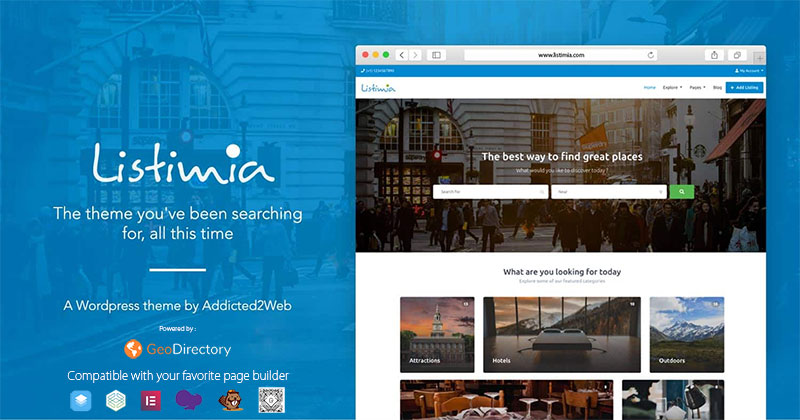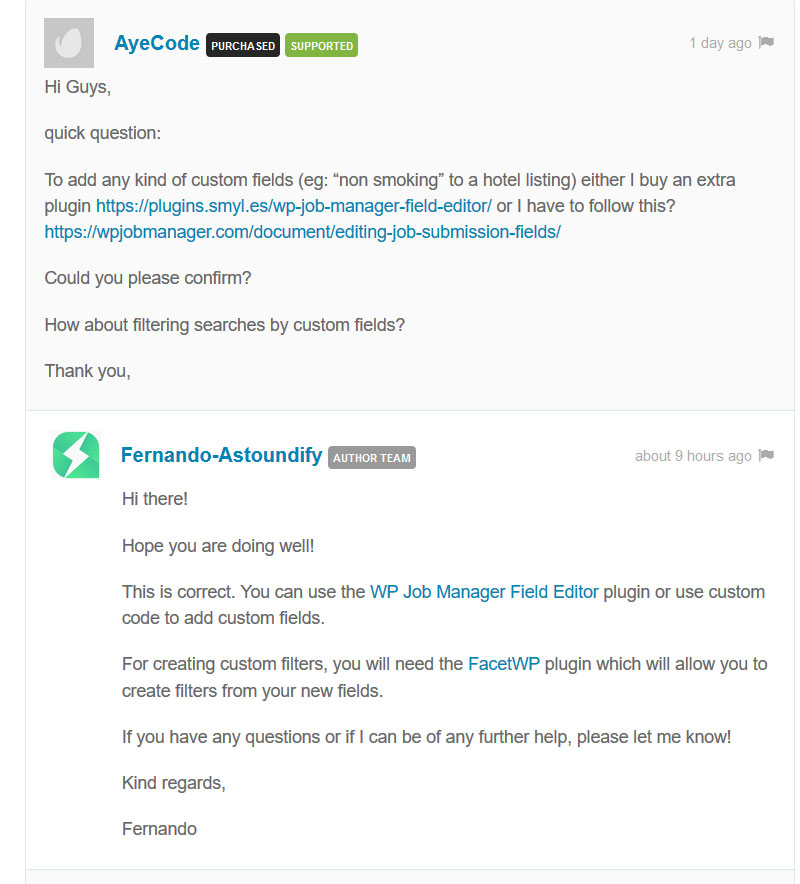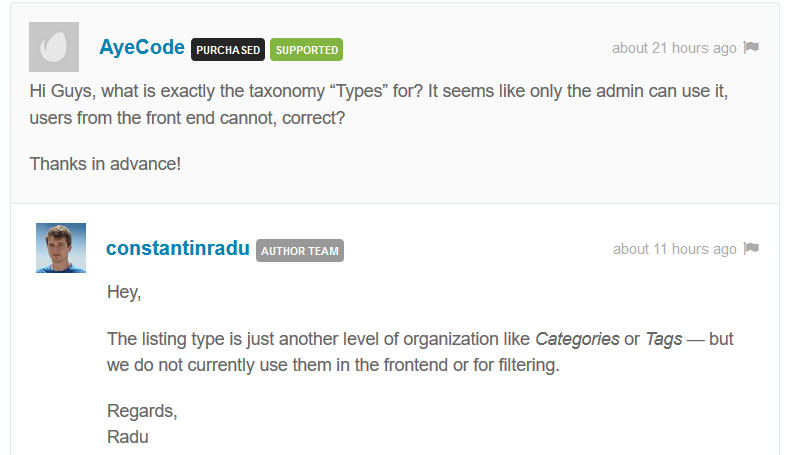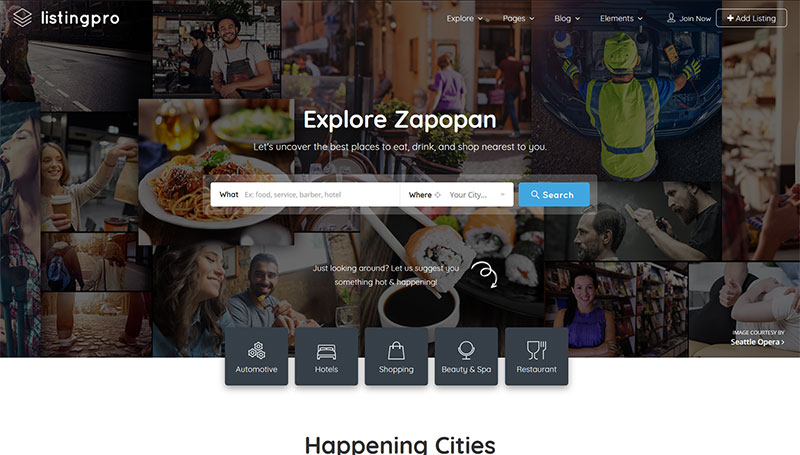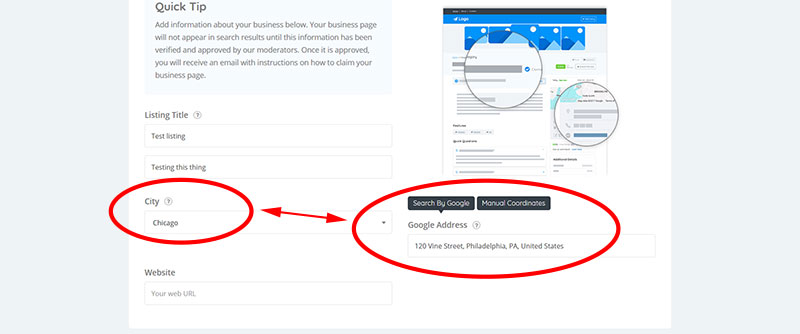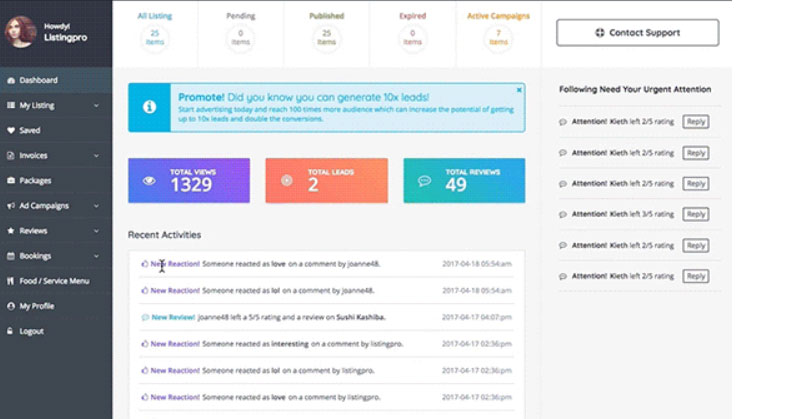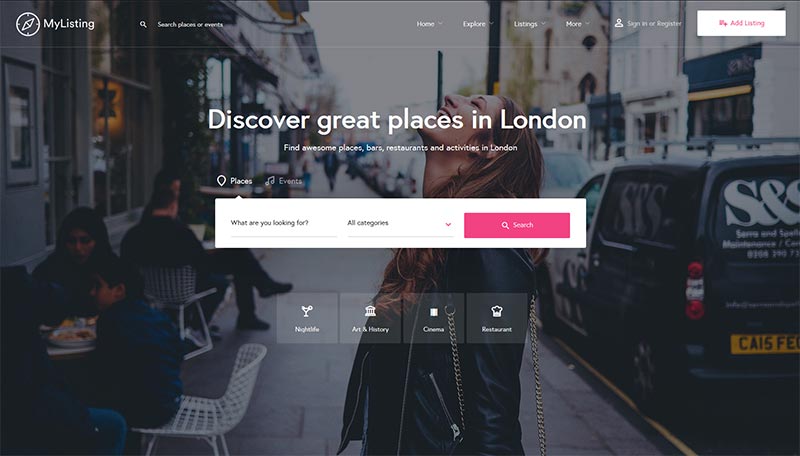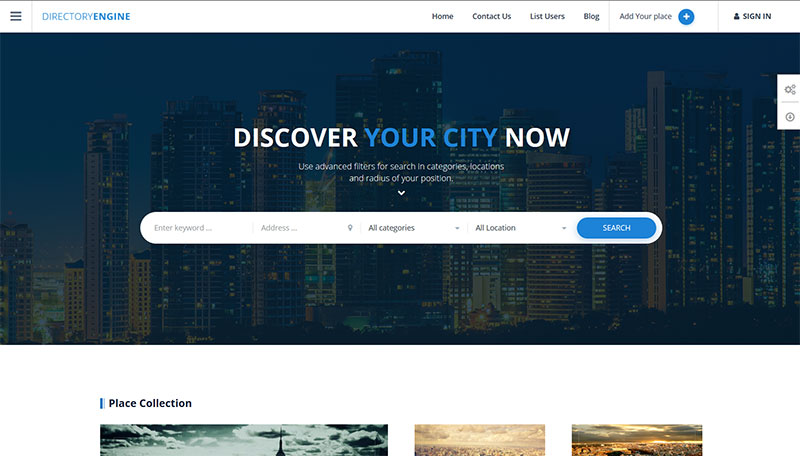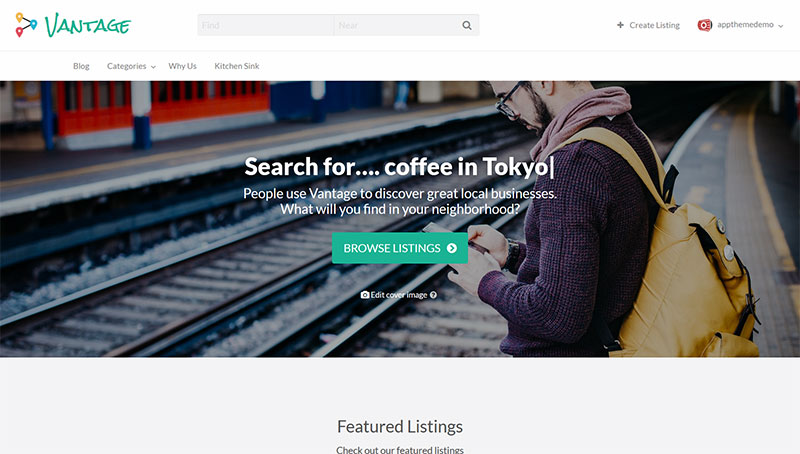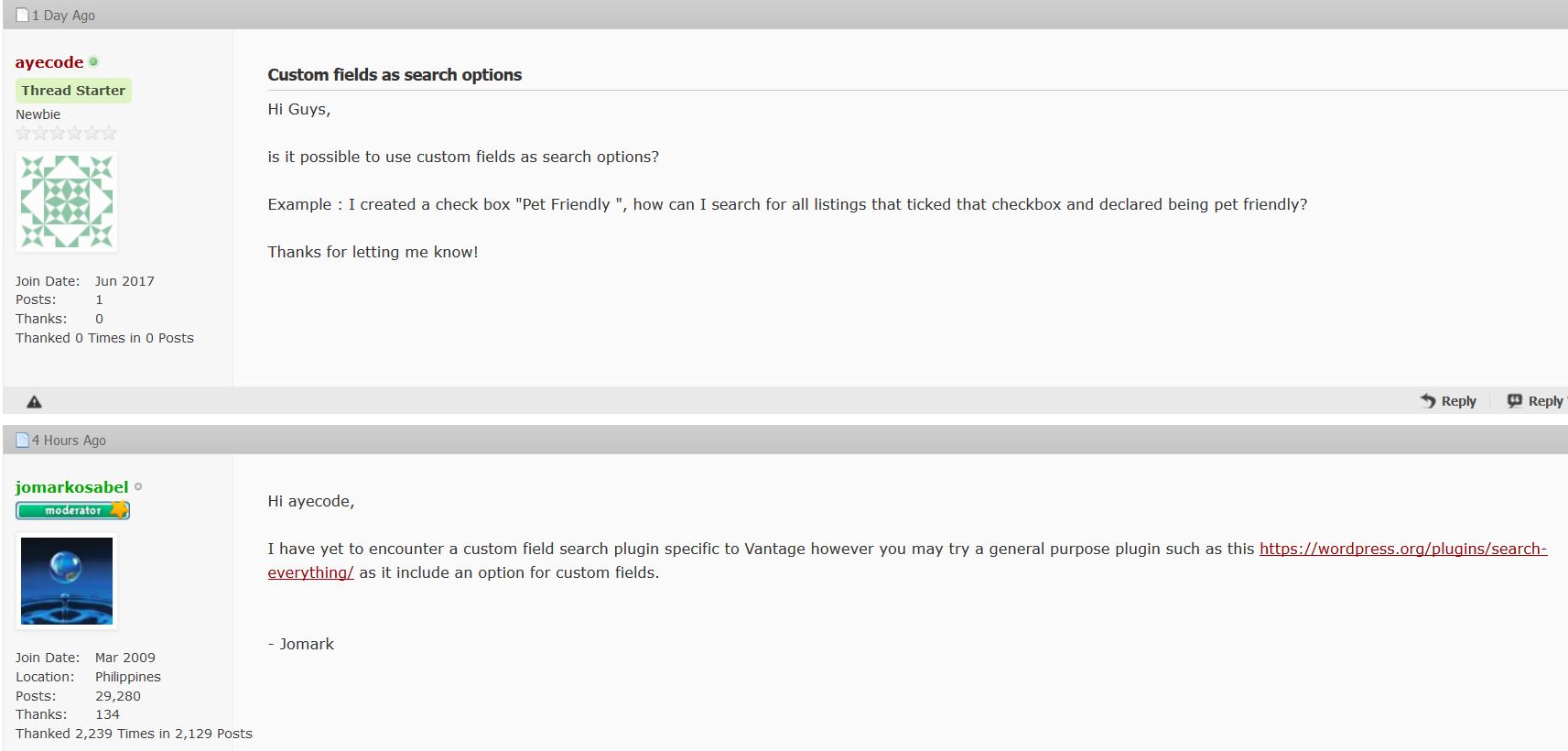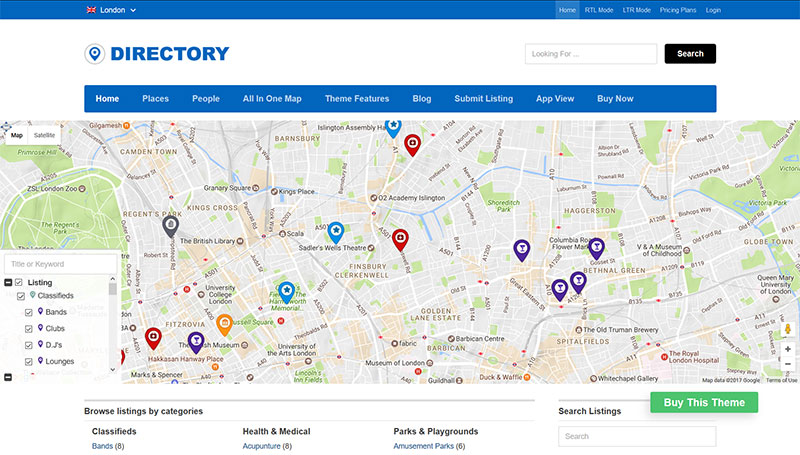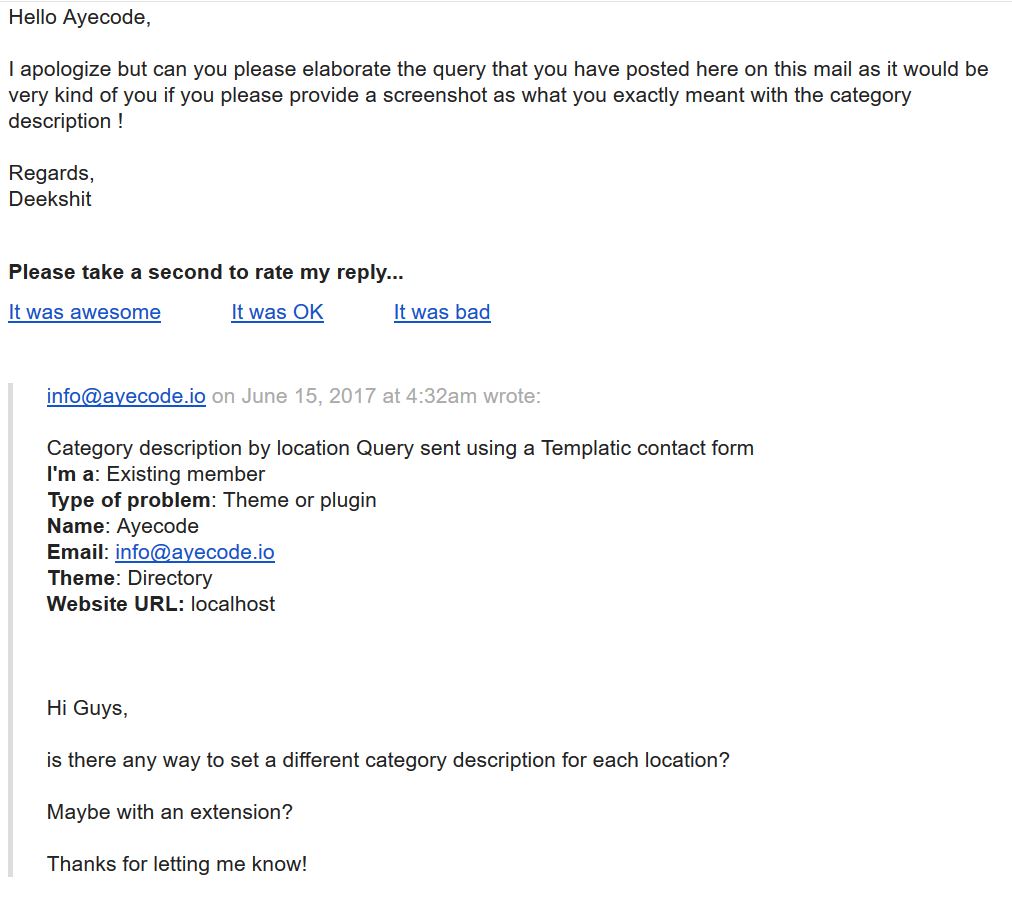WordPress Directory Themes
what's the best?
How the WordPress Directory Theme niche started
When we started this journey, there were only a couple of other players in the WordPress Directory Theme niche.
GeoPlaces by Templatic and Directorypress by PremiumPress.
At that point, Stiofan and I still didn’t know each other. We met in the Templatic forums after buying their theme to build our directories.
However, we found Templatic to be flawed, buggy, and unsuitable for use in developing a live website.
Stiofan started using it, adding fixes to it and making it work for him. It turned into his Barra directory website.
Over 80% of the theme needed major fixes, so we decided to team up, fork it, and create an alternative product.
That’s how we created GeoTheme. After that, Vantage from AppThemes was released and then we saw products popping up one after the other.
Today ThemeForest.net lists 163 items and counting that are a WordPress Directory Theme (last time we checked they were 157).
Several other independent Theme Shops sell their own WordPress Directory Theme too.
GeoTheme ceased to exist over 2 years ago. We decided to turn it into a plugin called GeoDirectory, so webmasters can use it anyway they see fit.
This allows directories to be added to any existing websites without any change being needed to the theme or website.
With so many options, which one to choose in 2021?
Our 1st answer would be Listimia + GeoDirectory for obvious reasons. Listimia was released in June 2019 and you can see it in this DEMO.
It only costs $39 and revolving around GeoDirectory makes it the most feature-rich Directory Theme for WordPress. Did we say it is sleek, elegant, and professional?
Should you prefer not to make this journey with us, at least let us help you choose wisely.
For that, we bought, installed, and tested the 7 most popular WordPress Directory Themes, so that we can provide scrupulous and objective reviews from specialists of the directory niche.
To praise their Pros and expose their Cons.
Affiliate link disclosure
We hope you appreciate our effort! Having invested $500 to buy all these themes, we need to recoup the investment. Some of the links on this article are “affiliate links”. This means if you click on the link and purchase the item, we will receive an affiliate commission.
Testing Criteria
First of all, we decided to test only 7 themes. The 4 top-selling themes of the moment from ThemeForest.net and the 3 top rankings on the Google.com SERP for the keyword “WordPress directory theme”.
They are:
1) Listify by Astoundify
2) Listable by Pixelgrade
3) ListingPro by Cridio Studio
4) MyListing by 27collective
5) DirectoryEngine by EngineThemes
6) Vantage by AppThemes
7) Directory by Templatic
We will test and evaluate them for:
1) Ease of use
2) Design quality
3) Flexibility
4) Use of SEO best practices
5) Quality of support & documentation
6) Quality of code, use of WordPress best practices, and scalability
Why didn’t you review this or that other theme too?
Because of time restraints. There are hundreds of them and we couldn’t review them all. We picked the theme for which the market was showing the strongest preference.
Listify by Astoundify
Ease of use
Installing and setting up this theme was as straightforward as could be.
The setup guide allows you to set up a staging website in less than 5 minutes.
The only tedious part is the procedure to get the Google Maps API Key, which was more of a struggle than anything else in the rest of the install wizard.
I suggest the authors look at our API KEY for Google Maps plugin.
They’ll learn how to streamline the procedure from several steps to a couple of clicks.
Design quality
Listify design is outstanding and easily customizable and should prove accessible even to users with little to no coding/CSS knowledge.
The “Customizer” section contains Style Kits and other options for the user to modify the website style like the logo, elements colors, labels, and typography.
Flexibility
A 3rd party plugin, called WP Job Manager, actually powers the theme, so
there are few built-in options for the management of fields and links.
The first thing that I wanted to test was custom fields to see how Listify handles the posts meta.
I was surprised to find that it basically doesn’t actually handle fields very well.
If you want to add a custom field to the front end add-listing form and listing pages, you have to add code snippets to your child theme or buy yet another premium plugin.
Search filters by custom fields as a consequence are not available. You can filter by location, by category, by keyword, or by tag.
With an extra premium plugin called FacetWP, you can extend that, but I didn’t test it and I can’t say to what extent.
Listify is compatible with WPML, but Polylang is recommended to create a multilingual website.
Use of SEO best practices
The location field is a taxonomy. Because of that, this theme is more suited for a local directory. Bootstrapping a successful website with multiple locations could be next to impossible.
You can search and filter by category and location. But you can only browse archives of listings by location OR by category. For Directories with listings from more than one city, this is a huge SEO limit.
If you want to see the “Private Room” listings in San Diego on the Listify demo, you can only do that by using their search engine. If you copy the URL returned :
and paste it a new browser window, you will see that it won’t show “Private Room” listings in San Diego, but a generic search results page.
This is SEO unfriendly.
You can’t handle SEO meta with SEO Yoast for similar search results pages.
No relevant Title. No relevant metas. Nothing in the URL to help Google index your website for “Private rooms in San Diego”.
For a good directory there should be an archive under a similar structure:
listify-demos.astoundify.com/rentals/united-states/california/san-diego/single-room
That structure allows to assign a unique meta title and meta descriptions and it would be 100% SEO optimized.
Listify handles Rich Snippets but it integrates them in the most basic way possible.
Quality of support & documentation
The documentation is extensive and clear. Support is also polite and efficient.
I submitted one query via comments on the product page and received a response in less than 24 hours.
Quality of code, use of WordPress best practices, and scalability
Out of the box, because it doesn’t use Custom Fields, Listify is scalable, in a similar manner to how WordPress is for posts and pages.
Adding custom fields to the equation, via code snippets or plugin, would quickly degrade performances. This because of how the custom fields are saved in the database.
Code Comments: In general, the code quality is good, lots of the important functions have code comments, but there are still many without any comments or that lack full descriptions, and as such would not be up to WordPress standards.
Actions & Filters: The theme has 134 do_action() and 187 apply_filters() which is good to see (in general the more actions and filters the easier it is for developers to work with).
Escaping (security): Seems good and up to WP standards.
Listify conclusions
While great design and quick setup are definitely obvious pros, this theme is, unfortunately, totally dependent on other plugins. In our opinion, Wp Job Manager is less than ideal for building a business directory.
Since Astoundify has been sold and we don’t know the new developers, I can’t guarantee that Listify is still as stable as it was when we 1st tested. If and when we’ll get the time to check the latest updates, we’ll report here.
Listable by Pixelgrade
Ease of use
Listable gave a very good first impression, although it wasn’t as smooth and fast as the previous one.
After a few minutes of work, my staging website looked similar to the Listable official demo.
Listable features Mapbox integration. Mapbox is an alternative to Google Maps, although it offers only 1600 map views per day and becomes pretty expensive after that, so it’s not a great choice.
Google Maps is available. They require adding the API key manually, which is time-consuming. Listable’s authors should have a look at what we suggested to the Astoundify team about this.
Design quality
Listable’s major strength is its sleek and pixel-perfect design.
Their customizer options allow the editing of most elements. Tweaking Colors Schemes, Managing Fonts, or adding Custom CSS
Flexibility
Just like Listify, Listable’s weakest point is the plugin powering the directory. WP Job Manager, which I think is far from ideal for a business directory.
Again, in order to create custom fields, you need an extra premium plugin or extra code. The only difference is the Locations that are not a taxonomy, but a post meta.
An extra taxonomy offered is the listing types. I didn’t see their utility because they appear to be for admin only.
Listable is fully compatible with WPML. I tested it and can personally confirm.
Use of SEO best practices
Even though the Location field is not a taxonomy (it is a custom field), the issues are the same that we saw with Listify.
Google will never index your category archives by city (if you have more than one).
A Directory of Hotels located in several cities, including New York, will not rank for keywords like “Hotels in New York”.
With this structure is better to create a single city or a hyper-local directory only.
Listable handles Rich Snippets, but it integrates them in a basic way.
Quality of support & documentation
The documentation is extensive and clear and support is polite and efficient.
I submitted one query via comments on the product page and received an answer in less than 12 hours.
Quality of code, use of WordPress best practices, and scalability
Out of the box, because it doesn’t use Custom Fields, Listable is scalable just like Listify.
But like Listify, if you try to add custom fields performance problems quickly arise.
Code Comments: Some code comments exist, but most functions are un-commented and ones that have comments are not up to WP standards.
Actions & Filters: The theme has 141 do_action() and 136 apply_filters() (in general the more actions and filters the easier it is for developers to work with).
Escaping (security): Mostly good and to WP standards though I would like to see all POST data escaped even in the backend functions.
Listable conclusions
Great design and easy setup, but same problems as Listify, as again their choice to use WP Job Manager limited their potential.
Also, because most of the plugins are premium, I couldn’t test them all. Buying them all would bring the total investment to over $300.
For example, I couldn’t test paid listings, claim listings, bookmarks, and listings tags. All monetization options come at an extra cost.
The same consideration I made for Listify is valid for Listable too. It’s a shame that it’s not compatible with GeoDirectory. Plenty of our current members would have bought it.
ListingPro by Cridio Studio
Ease of use
Things didn’t go very smoothly with ListingPro at first. I unzipped the archive and found 5 zip files in it:
- Documentation-1.0.zip,
- listingpro.zip,
- listingpro-Bulk-import-addon.zip,
- listingpro-child.zip, and Live-demo-Content.zip.
I installed both the parent and the child theme and activated the child theme. I was redirected to the setup wizard page, where the first step requires installing the mandatory and recommended plugins. This step failed and I couldn’t proceed.
I had to ask for support, which, fortunately, was very fast in getting back to me. They explained that to set up everything I had to activate the parent theme. This shows the process is buggy because activating the parent or child theme shouldn’t change anything.
If it’s better for the setup process to activate the parent theme first, why not hide the child theme zip file and add a step to the setup wizard that installs and activates the child theme once everything else is done? (Like Listify does.)
In any case, after activating the parent theme the problem was gone and I had a staging website similar to their official demo to start my tests.
The author added a default Google Maps API key, to avoid users seeing an error on their maps when first visiting the website.
This is good and bad.
It’s positive to avoid showing an error to the users at first. But that API key will quickly reach its limit, all users that missed changing it and will be presented with the map error. Possibly when their website is live, which is worse.
And, as in the two previous themes, with ListingPro you can’t fetch the Maps API automatically.
Design quality
The front-end design for ListingPro is outstanding and the customization options are limitless, but the excessive use of colors on the dashboard is a bit grating and quickly becomes an eyesore.
I prefer when plugins and themes blend graciously into the WordPress UI, using its original styles and elements.
ListingPro doesn’t use the Theme Customizer for its styling and customization options. Being all in the dashboard theme options means that you can’t preview your styling changes while doing them.
Flexibility
ListingsPro is a WordPress Directory Theme that comes with all Directory features built-in. It doesn’t rely on 3rd party plugins to operate the directory portion of the theme.
This is a big advantage, especially for those on a tight budget.
Unlike WP Job Manager, ListingsPro handles custom fields. You can create fields of the following types: Text, Checkbox, Checkbox (Switch On/Off), Multi check, Radio, and Select.
Custom fields are unavailable as advanced search filters and are only used as Additional Business Info. Advance search filters are predefined and the admin cannot edit them. They are Price, Open Time, Highest Rated, Most Reviewed, and Categories.
Locations are a Taxonomy and the add listing page requires to select a location. This means that if you want to build a countrywide directory, you must enter all Cities of that country in advance.
Because there is no proper validation, you can input an address from a city (even if is not valid) and select a different city as your location. This is sloppy design, and could really use a more thought out approach from the designer.
Another taxonomy offered is: “features”. Features are category dependent. A taxonomy nested within another taxonomy.
ListingPro features two options for monetization: Paid listings and ads. Paid listings allow the enabling and disabling of a few options.
You can show or hide: Contact information, Google map, Video, and the Gallery.
Paid Ads give listing owners the option to buy extra impressions in featured areas of the theme. This is very interesting but its implementation is pretty basic. For example, you can only set one price and ad duration per ad slot.
Our favorite section of this theme is the User Dashboard. It is very well thought out
Use of SEO best practices
ListingPro has the same flaws in this aspect that the previous two themes had. It doesn’t provide Search Engine friendly archives of categories filtered by location.
Not really suitable for a Directory covering multiple cities, it can be used for a hyper-local or city directory with a limited number of listings.
ListingPro doesn’t handle Rich Snippets.
Quality of support & documentation
Documentation is not 100% complete and it can’t be searched. Support is extremely efficient, we posted 1 comment and received a reply within minutes. I was invited to use their ticketing system, which was a positive and user-friendly experience
Quality of code, use of WordPress best practices and scalability
The manner in which data is stored in the database makes ListingPro the worst theme so far, at least in terms of performance and scalability. Everything is saved as posts and post meta. Listings, Prices, Ads, Reviews, Invoices, and Claims are all post types.
With a total of 9 listings, I had 82 rows in the wp_post table and 1340 rows in the wp_postmeta table.
Building a directory with thousands of listings using this theme would be literally impossible without spending a fortune on hosting.
Code Comments: Very basic comments exist for some things but in general most things have no comments. I did not find any comments up to WP standards.
Actions & Filters: The theme has 14 do_action() and 31 apply_filters() (in general the more actions and filters the easier it is for developers to work with).
Escaping (security): Very poor escaping and we actually found an extremely serious XSS vulnerability during our basic checks (we have reported this to the author)
ListingPro conclusions
A great design with some very good ideas, but an overall immature product with too many major architectural flaws.
It reminds me of Templatic’s GeoPlaces.
It is obvious that the author studied the graphic side of this project in great detail. But it is also evident that whoever wrote the code had little to no experience building high-performance scalable applications.
They also need to learn how to make their code secure. Codewise this is the 3rd worst tested theme.
ListingPro is currently not suitable for a live application in our opinion.
MyListing by 27collective
Ease of use
I started installing MyListing in a multisite network but had a hard time recreating a demo through WP All Import. That is their suggested tool to import dummy data and create a demo. I’m not sure if this is a known issue or if missed something.
When I tried on a standalone WordPress install the problem was no longer there and I was up and running with a demo very similar to their official demo in just a few seconds.
MyListing requires several plugins to be installed:
- Wp Job Manager
- WooCommerce
- Elementor
- All-in-One WP Migration
- Contact Form 7
Because of this, fast loading pages are to be expected on high-performance servers only.
Even their demo is not extremely fast and loads on average in 7.4 secs when tested from 20 locations.
On a live directory website that would result in a very high bounce rate.
We used this speed loading test tool to get those statistics.
As with all previous themes tested MyListing won’t allow you to fetch the Maps API automatically.
Design quality
MyListing is highly integrated with the Elementor plugin and offers a lot of customization options. You can basically design most of it through the Elementor page builder.
You can customize the home page, the explore page (search), and a few other templates. You cannot edit the listing detail page.
The general design quality is outstanding, although I find the typography to be slightly too small for modern standards and hard on the eye.
MyListing is another theme that doesn’t follow WordPress standards and avoid using the Theme Customizer, for its styling and customization options.
Flexibility
MyListing uses WP Job Manager as a base for the directory and shares the same limitation of Listify and Listable. They integrated the Advanced Custom Fields plugin for some theme options, and also built their own custom fields system.
Prices are set through WooCommerce, as products and the payments are managed by WooCommerce too.
In our opinion, this is a bit too much. We developed a lightweight plugin called Invoicing plugin to manage payments for GeoDirectory because any other e-commerce system was adding an excessive amount of useless code to the directory.
For example, you’ll have a system to manage parcel shipping, on a website that doesn’t ship anything.
Use of SEO best practices
MyListing has the same flaws in this aspect that the previous 3 themes had. Custom Taxonomies are used for categories and locations, which means that it’s impossible to visit a page showing listings of 1 category for a specific location with a nice SEO optimized URL.
Mylisting handles Rich Snippets, but it presents few errors too.
Quality of support & documentation
The documentation appears to be complete and it can be browsed via the sticky menu on the left sidebar. We haven’t tested support, but I don’t see negative reviews for inefficient or substandard support, so they must be doing a good job.
Quality of code, use of WordPress best practices, and scalability
Because they used the default WordPress architecture for custom fields, scalability for MyListing will be a huge problem. I created 1 test listing with 5 images and that resulted in 7 rows in the wp_posts database table and 59 rows in the wp_postmeta database table.
MyListing conclusions
It’s definitely aesthetically pleasing, and, being easy to customize via Elementor, is a great tool for the beginner Directory Developers, but most of the projects built with this theme will have a very hard time scaling their business if the website starts getting traction.
This theme forces you to install:
Wp Job Manager, Wp Job Manager WC Paid Listings, Elementor, WooCommerce, and their own MyListing Add-on. It couldn’t get more bloated.
Someone may wonder why they have mostly 5-star reviews and no negative reviews at all. This struck me as suspicious, especially considering the flaws that we identified in this theme.
Apparently, people who leave negative reviews have been banned from getting support and updates.
That made me discover that Envato deletes reviews made by people who received a refund for any given product. I consider that an awful business practice by Envato.
While I’m not suggesting that this is MyListing authors standard behavior with customers, I can personally tell that they have a hard time dealing with negative feedback, because they also contacted me directly asking me to modify this review.
I’d suggest they take negative feedback as information to improve their product, rather than taking it as personal offenses and witch hunt anyone that dares to critique their product.
You can make a great-looking website with MyListing, but it will be slow to the point of becoming unusable if hit by a decent amount of traffic.
DirectoryEngine by EngineThemes
Ease of use
I’m not a fan of Themes that come with bundled plugins. Because most of the time the bundled plugins are out of date. You have to start the install by updating 1 or more plugins via FTP because the bundled plugin can’t be automatically updated (unless you buy a license for that too).
DirectoryEngine comes with 2 bundled plugins: Revolution Slider and Visual Composer, of course, both were outdated, and I had to update them via FTP.
The documentation tells to install the dummy data using the WP Importer plugin, and the theme provides a tool to automatically import it.
Like all 3 previous themes, the Google Maps API key must be generated manually.
All in all, it took me approx 15 minutes to get a staging site similar to their demo. That’s not too bad.
Design quality
The quality of the design is high, but not as pixel perfect and comparable to the previous 3 themes.
Customizer options allow to modify the sections of the home page and the general website colors only, and there are few really substantial design options.
Flexibility
DirectoryEngine is one more WordPress Directory Theme that doesn’t handle custom fields out of the box. They can be added, but only programmatically.
If you can’t create custom fields, you also cannot use them as search filters.
There are 4 custom post types: Places, Events, Packs, and Testimonials.
Places are used for listings.
Events are special offers that listings owners can add.
Packs are for listing prices.
Testimonials are not clearly defined and have no obvious use.
You can create unlimited listing prices, but all they do is limit the number of places and events that a user can enter and the length of their availability. There are settings to determine how many pictures or categories a listing can accept, but that will affect all prices.
Locations are items of a taxonomy.
Just like ListingPro, while adding a listing, you can select an address from a city and in the location field,m you can select a different city.
At the time of writing, DirectoryEngine is several years old, and I find this to be unacceptable. What’s worse, they describe this as a “feature” in the documentation:
Use of SEO best practice
DirectoryEngine has the same SEO flaws of all Themes tested so far.
Being location a taxonomy, there is no way to browse archives of listings of a given category filtered by a defined location. The only way to do it is via their search engine, which is not SEO friendly.
The way locations are handled is amateurish at best. You can rank a website made with DirectoryEngine on major Search Engines only if the directory accepts listings for 1 city or for a smaller geographical area.
DirectoryEngine uses rich snippets correctly.
Quality of support & documentation
The documentation seems to be slightly outdated, however it covers all features of the theme. Support replied within 24hrs the first time. The second time, when we reported a serious vulnerability in their theme, they didn’t reply at all.
Quality of code, use of WordPress best practices, and scalability
With 4 listings, 7 events, and 3 prices the post and postmeta tables have respectively 311 and 936 rows. I see here the same scalability problems that ListingPro has: insurmountable.
Code Comments: Most things have code comments and most are to WP standards though parameters, for the most part, lack descriptions, in general though, it is better than the vast majority.
Actions & Filters: The theme has 100 do_action() and 137 apply_filters() (in general the more actions and filters the easier it is for developers to work with).
Escaping (security): I started checking this code and the first 3 things I found had exploits such as XSS, login page spoofing, and the ability to view or delete content from the site.
DirectoryEngine conclusions
I had high expectations for this theme and after testing it, I can’t help but say that I’m disappointed. For a product that has been available for several years, it still has critical flaws, despite being widely used. I wouldn’t hesitate to ask for a refund if I had purchased it for my own personal use.
There is definitely a fine designer at work behind this theme, but the quality of the back-end application is rather unprofessional.
I would have to conclude the authors have very little knowledge of security and scalability. No one should ever install this theme on their site.
Vantage by AppThemes
Vantage has been around for several years, and as such it’s the most mature product on this list. It has been recently re-designed, and I have considered this a direct competitor for a long time. I was very curious to finally get my hands on it and properly evaluate it.
Ease of use
Installing and setting up Vantage was a very enjoyable experience. The setup guide is as good as the Install Wizard of Listify. I had a demo website that looked similar to the AppThemes original demo in less than 5 minutes.
The only weak point is the Google Maps API key requirement that could be streamlined, just like for the previous 4 themes.
Design quality
The new flat design is modern and clean, a huge step ahead compared to the old Vantage design.
The customizer options allow modifying the site identity elements like the logo and site icon. Color schemes, the color of individual items, background image, and layouts.
Flexibility
Out of the 5 themes tested so far, Vantage is the first that really handles custom fields. Because you can’t use them as an advanced search filter though, they are not as useful as they could be.
The location field is a text field. It calculates Latitude and longitude coordinates automatically from whatever the user input in it. The lack of validation on this field allows users to enter just about anything. Saving the form after inputting an invalid address returns PHP warnings.
The price option allows the setting of recurring and non-recurring prices. Limit the number of categories that a user can select for each listing. Set the listing duration period and featured status for search and category archives.
Available payment options out of the box are Paypal and Bank Transfer. There are extra payment gateways, child themes, and other premium extensions that come at an extra cost. We didn’t test any of them.
Use of SEO best practice
Just like the other themes, the Location part of Vantage is not ideal. It is not sufficient to create a decent Directory structure with listings submitted for more than 1 location.
You can rank the listing detail page and the category pages, but not by location. This because the only way to browse listings by location, is via the search engine that returns non SEO friendly results page, with URLs like this:
yoursite.com/listings/?ls=test&location=milan&st=listing&lat=0&lng=0
There is no way to assign a unique meta title and description to these search results pages. Because of that, it’s very improbable that Google or other search engines will rank them for relevant keywords and locations.
Vantage handles Rich Snippets, but it integrates them in the most basic way.
Quality of support & documentation
The documentation for this WordPress Directory Theme is extended and very well organized in 4 sections:
- Documentation – Install guides, release notes, and more.
- Tutorials – Our themes and plugins tutorial library.
- Developers – Our API documentation. Extend our products.
- Sellers – Documentation for our Marketplace sellers.
Support is very kind and helpful. I submitted a support request via their support forum and got an answer within 24 hours.
Quality of code, use of WordPress best practices, and scalability
Vantage doesn’t employ a database structure that is ideal for a directory. With only 3 listings, the wp_posts table had already 49 rows and the wp_postmeta 246. The use of extra custom fields would make the second figure grow exponentially.
Scalability problems could arise very soon without investing enough resources in high-end server infrastructure.
Code Comments: This is very well commented and most code comments are to WP standards, seeing so much quality code comments give a developer confidence.
Actions & Filters: The theme has 238 do_action() and 230 apply_filters() (in general the more actions and filters the easier it is for developers to work with).
Escaping (security): Security and WP standards were up to scratch. No major problems could be identified.
Vantage conclusion
Great design and excellent setup procedure. A directory can be set up and used within minutes. It is effective for use on a single-city directory.
However, it is unsuitable as a directory for a region, country or world-wide directory. It wouldn’t be SEO friendly.
Of the 7 themes tested, I would have to conclude that Vantage is definitely the best overall product.
Directory by Templatic
Ease of use
I tested this theme when it was first released, and I was unimpressed. However, the latest version left me pleasantly surprised. It’s fast, easily-installed, and makes import dummy data easy. I was able to set up a staging website identical to their demo in just a few minutes.
The level of improvement is impressive.
Design quality
When it was first released in early 2014, the design was modern and sleek, however now it starts to be a bit outdated, and while they provide several child themes with different designs, they all come at an extra cost.
Some of the design options are available in the customizer section, some in the theme setting. It’d be more convenient to have them all in the customizer.
Flexibility
Directory is by far the most flexible of all 7 tested themes in terms of features.
It handles Custom Post Types (Listing types), and for each Custom post type, you can create any kind of custom fields. Finally, you can use all custom fields as advanced search filters.
The theme database comes with all Countries listed and almost 4000 regions. The system creates cities when adding listings, but there is no tool to merge them, in case of typos or other database errors. This is something that shouldn’t be missed when users can add locations to the database.
Strangely, even though there are regions and countries, you are unable to browse listing by region or country, only by city. It’s a step forward compared to the other 5 themes, but still far from ideal. An ideal directory would include the option to browse by “All locations”, country, region, city, and neighborhood.
Money-making and business opportunities are very good. You can set prices with good flexibility. You can set Prices for “single submission” or for “subscription” including a set number of listings. Set them recurring or as one-time fee payments. Also, add an up-sell price for each category. Another option is the duration of the package and the featured placement of the listing.
Use of SEO best practices
Even though with Directory you can finally present archives filtered by category + location, the amount of flexibility in managing Titles and Metas is close to non-existent. You can create a category description, but that will be the same for all locations.
We are still very far from an ideally SEO optimized directory tool.
Directory handles Rich Snippets, but it integrates them in the most basic way.
Quality of support & documentation
The docs are very well organized and easy to search. Although their support team replied to my support request within 24hrs, they couldn’t understand my question, despite being pretty straight-forward.
Quality of code, use of WordPress best practices and scalability
Buggy code was what we best remember about Templatic’s themes. Directory is no different.
We found options that don’t save, security holes, and a deficient database structure.
The database structure is the worst of all Themes tested. With 13 listings, 15 pages, and 4 posts, the post table has 105 rows and the postmeta counts 1,308 rows.
Finally, the advance search widget queries are SQL killers. They JOIN the postmeta table once for each custom field that you filter.
Scaling this Directory Theme beyond a few hundred listings could be next to impossible.
Code Comments: Most things have some sort of code comments, somethings are to WP standards but not everything, maybe 50/50.
Actions & Filters: The theme has 487 do_action() and 319 apply_filters() (in general the more actions and filters the easier it is for developers to work with).
Escaping (security): Most things are escaped, but there are still lots of things that are not which could lead to XSS on the backend. In general, the code is sloppy with many PHP warnings and Notices and, in many places, lacks basic security checks for things like sending emails and SQL injection.
Considering the previous points, Directory isn’t something I would want to run on my server.
Directory conclusions
Compared to GeoPlaces of 4 years ago, the theme shows a lot of improvements. Especially in terms of new features and options, but the underlying structure is the same. Not scalable and buggy.
Final Conclusions
We were pretty shocked to discover that half of the themes tested were so poorly coded.
Similar products can undermine WordPress’s reputation in our opinion.
The quality of the backend application should always be equal or superior to the quality of the design.
If it’s unable to meet the standard of design then your customer is receiving a product that doesn’t match what was promised.
Obviously, we advised the Themes’ authors about the possible exploits and as far as we know the ListingPro authors already corrected its XSS vulnerability.
Apart from that, Vantage ranks #1, Listify #2, Listable #3, ListingPro, MyListing, and Directory tied #4 and DirectoryEngine is by far the worst.
The last four themes in our opinion are not suitable for a production website.
A message to the authors of Directory Themes
Why would you bother to build the directory features of your themes from scratch (or use a plugin that’s not made for it)?
If you had to develop an E-Commerce theme today, would you build the entire shopping cart or use WooCommerce for that?
Without a doubt, GeoDirectory is far superior to the Directory options included in all of the themes that we tested.
You are still in time to correct that mistake and let us handle probably 90% of the support requests that are sent your way.
Cooperating is better than competing 🙂
We hope you enjoyed this extended review and should you wish to add anything to it, please do so in the comments down below!
Newsletter - Stay Updated!
Get the latest news, tips, and exclusive content directly in your inbox.
